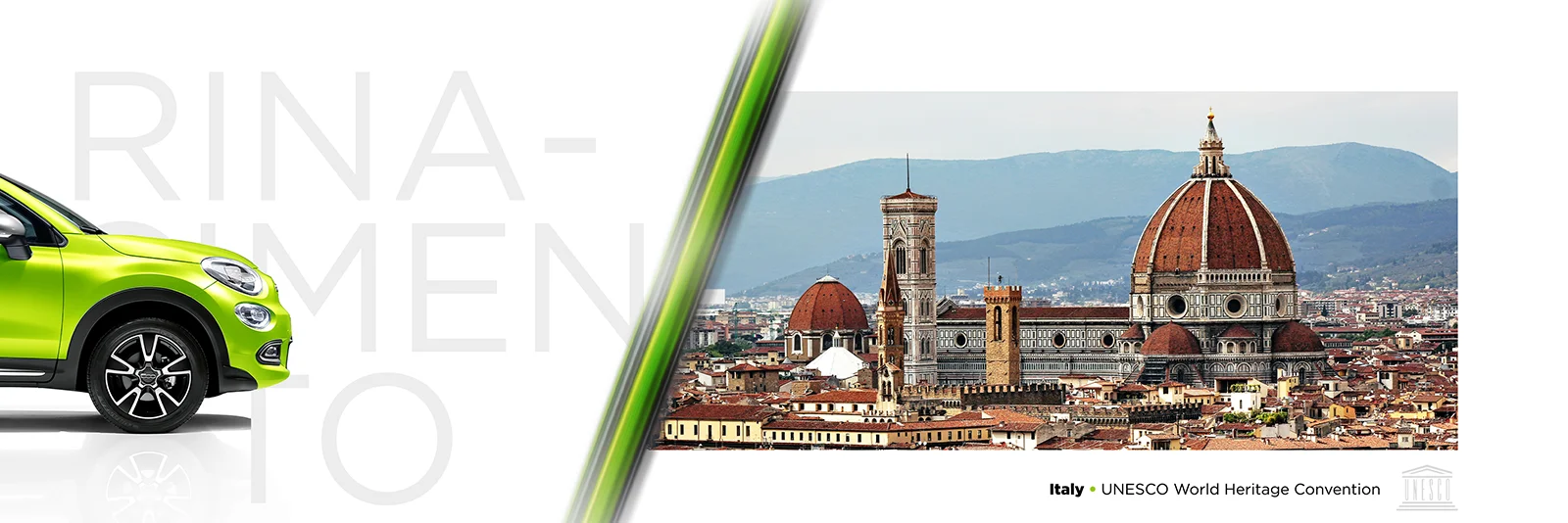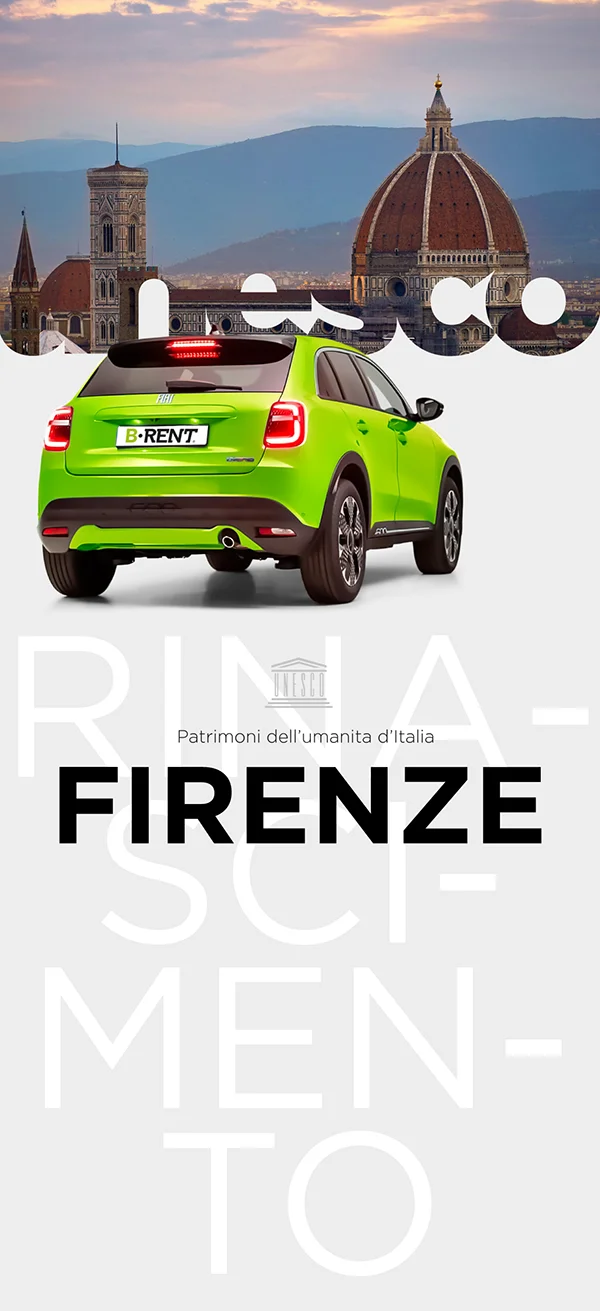IT
EN
ES
FR
IT
EN
ES
FR
The historic center of Florence is a treasure trove of art, once surrounded by the 13th-century city walls, of which only monumental towers and two fortresses remain: the San Giovanni Battista Fortress in the north and the Forte di San Giorgio a Belvedere in the Oltrarno area in the south.
Between the lively San Lorenzo neighborhood and the quaint Santa Croce district, Florence boasts the highest concentration of world-famous artworks. A stroll through its historic center will lead you from one masterpiece to another: the Cathedral of Santa Maria del Fiore in Piazza del Duomo, Palazzo Vecchio in Piazza della Signoria, the Uffizi Gallery, Ponte Vecchio, Palazzo Pitti, and the Boboli Gardens. Other notable sites include the Basilica of Santa Maria Novella, the Academy Gallery, and the Basilica of Santa Croce.
Florence's history began in 59 B.C. with the Roman foundation of the village of Florentia on the remains of ancient Etruscan settlements. From the year 1000 onwards, Florence's splendor grew exponentially, and its historic center expanded. For centuries, the center was delimited to the north by the city's Circumferential avenues and to the south by the banks of the Arno River. After the 1400s, when wealthy Florentine families began constructing beyond the river, the Oltrarno area became part of the historic center.

The Historic Center of Florence is a treasure of Renaissance art, culture, and architecture, located in the heart of Tuscany, Italy. Florence is often called the cradle of the Renaissance for its central role in the development of this artistic and cultural period. Declared a UNESCO World Heritage Site in 1982, Florence’s historic center is recognized for its extraordinary beauty and lasting impact on global culture.
Florence was founded by the Romans in the 1st century BC as a colony called **Florentia**. Thanks to its strategic position along the Arno River, the city flourished as a commercial and cultural center in the Middle Ages, reaching its peak during the Renaissance.
In the 15th and 16th centuries, under the leadership of the Medici family, Florence became a hub of artistic and intellectual innovation, attracting prominent artists and thinkers such as Leonardo da Vinci, Michelangelo, and Dante Alighieri. The city transformed into a laboratory of new ideas and artistic techniques, which would profoundly influence European culture.
The historic center of Florence is an exceptional example of Renaissance urban architecture, with a unique collection of religious, civic, and commercial buildings that testify to the city’s wealth and power during the Renaissance. Its monuments and museums preserve some of the world’s most famous artworks, making Florence one of the most sought-after destinations for art and history lovers.


Visiting the Historic Center of Florence offers a unique opportunity to explore the cultural and historical heritage of the Renaissance. Every corner of the city tells a story, allowing visitors to immerse themselves in the beauty and creativity that have made Florence one of the most captivating cities in the world.
The Historic Center of Florence is easily accessible thanks to a well-developed transportation network:
To make the most of your visit to the Historic Center of Florence, here are some useful tips:
The Historic Center of Florence represents a fundamental part of Italian Renaissance history and culture, offering a fascinating journey through the legacy of an era of artistic and cultural innovation. These sites are living testimonies of a time of prestige and power, merging past and present into a unique and unforgettable experience.
Exploring the Historic Center of Florence means immersing oneself in cultural heritage of immeasurable value, discovering the roots of a civilization that has left a lasting mark on European history. A journey to these places offers a chance to experience Renaissance history and culture in its splendor, admiring the architecture, art, and natural beauty that continue to inspire generations of visitors.
The Historic Center of Florence is a unique testament to the influence the city has had on the cultural and artistic development of Europe. Florence served as a crossroads of ideas and innovations, a place where art and culture flourished under the patronage of the Medici family and other noble families.
The city was home to some of the greatest artists and thinkers of the Renaissance, and its historic center still retains the charm and elegance of that period. Florence is an extraordinary example of how art and culture can transform a city and leave a lasting mark on history and society.
In 1982, the Historic Center of Florence was recognized as a UNESCO World Heritage Site, underscoring its universal value as an example of a Renaissance city. This recognition promotes the preservation and enhancement of the city's historical and artistic heritage, ensuring the protection of its extraordinary cultural treasures.
Its inclusion on the World Heritage list highlights Florence’s importance as one of the most significant cultural and artistic centers in the world, offering a unique perspective on the evolution of European art and culture.

Visiting the Historic Center of Florence provides a unique opportunity to explore the cultural and historical heritage of the Renaissance. Every corner of the city tells a story, allowing visitors to immerse themselves in the beauty and creativity that has made Florence one of the most fascinating cities in the world.
The Historic Center of Florence is easily accessible thanks to a well-developed transportation network:
Here are some useful tips to make the most of your visit to the Historic Center of Florence:
The Historic Center of Florence represents a fundamental part of Italian Renaissance history and culture, offering a fascinating journey through the legacy of an era of innovation and artistic beauty. These sites are living witnesses of a prestigious and powerful epoch, combining past and present in a unique and unforgettable experience.
Exploring Florence’s Historic Center is an immersion into a cultural heritage of immense value, revealing the roots of a civilization that left a lasting mark on European history. A journey here is an opportunity to experience Renaissance history and culture in its splendor, admiring the architecture, art, and nature that continue to inspire generations of visitors.
Looking for enchanting destinations for a short road trip? Here are some must-visit spots near Florence.
About 40 km southwest of Florence, you can visit the picturesque town of San Gimignano, famous for its impressive medieval towers. Its historic center has been recognized as a UNESCO World Heritage Site for its well-preserved architecture, offering an extraordinary example of medieval urban planning. Stroll through its cobbled streets and enjoy panoramic views of the surrounding hills.
The Val d'Orcia, located about 90 km south of Florence, is another Tuscan gem recognized by UNESCO. This idyllic landscape is characterized by rolling hills, cypress trees, and picturesque villages like Pienza and Montalcino. The Val d'Orcia is perfect for those seeking a nature escape and wanting to savor the famous Brunello di Montalcino wine.
Finally, about 80 km west of Florence, the Leaning Tower of Pisa in the Piazza dei Miracoli is an Italian icon and a World Heritage Site. In addition to the tower, the square hosts the cathedral, the baptistery, and the monumental cemetery, offering a day rich in culture and architectural marvels.
In Florence, as in many major Italian cities, car preferences are influenced by urbanization and sustainable mobility policies. The most popular models in the city reflect the need to move easily through traffic and adhere to environmental regulations. Here are some of the most chosen cars:
Sustainable mobility is a central theme in Florence, and compact, hybrid, and electric cars are gaining popularity among residents.
The Toyota Yaris Hybrid is becoming increasingly popular in Florence thanks to its fuel efficiency and low emissions, ideal for a city that promotes sustainable mobility. The ability to drive in restricted traffic zones (ZTL) and incentives for hybrid vehicles make the Yaris a practical choice for those living or working in the city. Its compact size, combined with hybrid technology, offers an eco-friendly and agile driving experience in Florence's urban traffic.

In the Middle Ages, Florence was known as "Florentia", a name dating back to Roman times, meaning "flourishing" or "blooming." This name reflected the city's prosperity from its Roman origins. Over the course of the Middle Ages, the name "Florentia" gradually evolved into "Firenze" in the vernacular, still carrying the meaning of a city destined to grow and thrive. Florence later became an important cultural, economic, and political center during the Renaissance, solidifying its role as one of Italy's most influential cities.
Florence is often referred to by various epithets that highlight its history, beauty, and cultural significance. Among the most well-known are "Cradle of the Renaissance," due to the city's fundamental role in the development of this important artistic and cultural movement, and "Florence the Beautiful," referring to its extraordinary architecture and the artistic masterpieces it houses. Florence is also called "The City of Lilies," as the lily (or "fleur-de-lis") is the symbol of the city. Another epithet is "Athens of Italy," which praises its contribution to culture and art, comparing it to ancient Athens. Finally, it is simply known as "Fiorenza" in literary and poetic texts, a name that preserves the elegance and tradition of the past.
The historic center of Florence, as we know it today, is the result of centuries of development and contributions from many historical figures, architects, artists, and powerful families. The city began to develop during the Roman period, but it was during the Middle Ages and the Renaissance that Florence reached its architectural and cultural peak. One of the most influential families in the construction and development of Florence's historic center was the Medici family, who ruled the city for much of the Renaissance. Under their patronage, architects such as Filippo Brunelleschi, who designed the dome of the Cathedral of Santa Maria del Fiore, Leon Battista Alberti, author of the facade of the Basilica of Santa Maria Novella, and artists like Michelangelo and Donatello contributed to transforming Florence into a center of artistic and architectural excellence. Other important buildings, such as the Palazzo Vecchio and the Uffizi, were constructed under the guidance of the Florentine Republic and its rulers. The result is a historic center rich in masterpieces, now a UNESCO World Heritage Site.